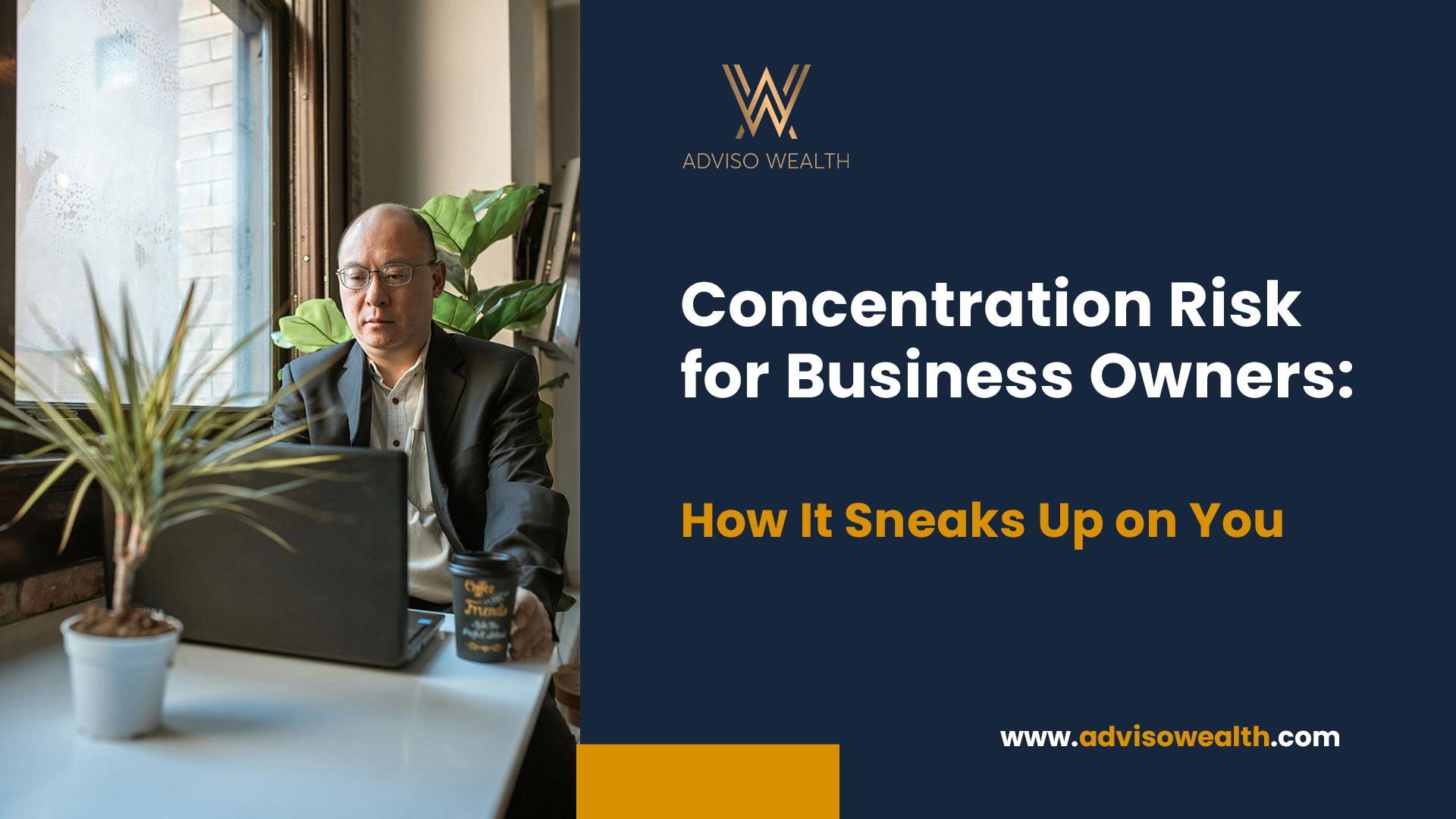Concentration Risk for Business Owners: How It Sneaks Up on You

It’s simple for entrepreneurs to concentrate on expansion, customers, or their top-performing product, but what if doing so jeopardizes your entire company? Concentration risk of business owners usually arises subtly if you depend too much on one client, one source of income, or even your own position. It is not an issue until a major agreement expires, a crucial employee leaves, or market expectations change.This blog explains how concentration risk can surprise business owners, why it happens more frequently than you might imagine, and what you can do right now to secure your future.
"The same thing that built your success may quietly be your biggest vulnerability."
When I sit across from business owners—smart, strategic, driven people—this truth surfaces over and over:
Your greatest financial strength may also be your greatest financial risk.
It’s called Concentration Risk, and for business owners, it often hides in plain sight.
Or, as Warren Buffett famously said:
“Wide diversification is only required when investors do not understand what they are doing.”
Buffett’s point? Focus is powerful—but too much, unchecked, can become dangerous—especially when your entire net worth rides on your business.
Your Business Is Your Concentration Risk—And It Feels Personal
If you’re like most owners I work with, your business isn’t just an asset. It’s your life’s work. Your pride. Your family’s future.
But here’s the hard truth:
For many business owners, 80% or more of their net worth is locked inside their company.
That’s like holding 80% of your investment portfolio in a single, illiquid, high-risk, emotionally charged stock.
In the public markets? No credible advisor would ever recommend that.
But in business ownership? It’s shockingly common.
And no one talks about how exposed that makes you—until it’s time to exit.
And by then? It’s often too late to diversify without significant consequences.
Traditional Investment Risk vs. Business Concentration Risk
If you’ve worked with a financial advisor, you’ve heard the mantra:
“Don’t put all your eggs in one basket.”
Simple in theory. But for business owners, it’s not so black and white.
The Similarities:
- Overconcentration anywhere—stocks or your business—creates real financial risk.
- Both limit flexibility when life changes.
- Both can unravel your retirement, your family’s stability, and your legacy.
The Differences:
- You can’t sell your business on a whim like a stock.
- Your business holds your identity—the late nights, the risk, the sweat equity.
- “Diversifying” means years of intentional planning, not a phone call to your broker.
- Market forces, industry shifts, health, or burnout can all derail your wealth—fast.
And perhaps most important:
Your emotional connection to your business makes objective decisions harder.
For most owners, the business isn’t just financial—it’s deeply personal. That’s what makes navigating concentration risk uniquely complex.
How Standard Advisors Get This Wrong
An advisor who doesn’t specialize in business owners might say:
- “Just sell the business.”
- “You’re too concentrated—move your wealth elsewhere.”
- “This is black and white.”
But you and I know—it’s anything but.
Your business is more than a line item. It’s decades of risk-taking. The sacrifices your family made. The vision you chased.
Exiting isn’t a transaction—it’s a transition. And transitions are never black and white.
It’s why owners often feel stuck, knowing they’re too concentrated but unsure how to unwind that exposure without jeopardizing everything they’ve built.
What an Advisor Who Understands Business Owners Does Differently
When you work with someone who’s walked this road with business owners before, the conversation shifts:
- We respect the emotional and financial complexity.
- We acknowledge your business is your greatest wealth engine—and your greatest risk.
- We build a roadmap to reduce overconcentration, without forcing premature decisions.
- We help you diversify—strategically, over time.
- We balance protecting your wealth and honoring what you’ve built.
This isn’t about fear. It’s about options. And options come from clarity and planning.
We also help you think beyond your business, about how wealth outside the business gives you choices:
- Choices about when—and how—to exit.
- Choices about your lifestyle.
- Choices about how you support your family, your causes, and your community.
Reducing concentration risk is about creating freedom.
The Hidden Cost of Ignoring Business Concentration
Meet Sam.
Sam spent 25 years building a thriving manufacturing business. By the numbers, he was worth $15 million.
But here’s the catch:
- $13 million of that was locked inside the business.
- 70% of revenue came from three clients.
- There was no succession plan. No personal wealth outside the company.
Then a health scare hit.
Within 18 months:
- The largest client left.
- Business value plummeted.
- Sale options dried up.
- Sam’s retirement—and his family’s stability—hung by a thread.
All because he never addressed his business concentration risk—until it was too late.
Unfortunately, Sam’s story isn’t unique. I’ve seen variations of this play out countless times—and the common thread? Waiting too long to face the reality of wealth concentration.
The Emotional Toll of Wealth Concentration
For many business owners, wealth concentration creates more than financial risk—it creates emotional pressure:
- The constant worry: “What if something happens to me?”
- The hidden stress of feeling trapped.
- The frustration of being told “just sell” when you’re not ready—or when your business isn’t ready.
- The guilt of not having prepared for your family’s future.
Addressing concentration risk isn’t about eliminating risk entirely—that’s impossible.
It’s about:
- Reducing exposure.
- Creating liquidity.
- Expanding options.
- Protecting what matters most.
All while honoring the years of work and sacrifice you’ve poured into your business.
How to Reduce Wealth Concentration and Reclaim Control
1. Get a Realistic Business Valuation
Understand what your business is actually worth—not what you hope.
2. Build Personal Wealth Outside the Business
Strategically transfer profits into diversified, liquid assets.
3. Reduce Customer and Market Dependence
Broaden revenue streams and customer base.
4. Develop a Succession and Exit Roadmap
Plan years ahead to reduce overexposure without sacrificing control.
5. Start Sooner Than You Think
Closing the wealth concentration gap takes time. Options shrink the longer you wait.
6. Stress-Test Your Wealth Plan
Model different exit scenarios. Understand how your wealth and lifestyle hold up if things don’t go perfectly.
7. Engage the Right Team
Exit planning, tax strategy, and wealth management—this requires coordination among advisors who understand business owners.
Want to Know How Concentrated Your Wealth Really Is?
At Adviso Wealth, we help business owners turn complex wealth concentration risks into clear, actionable plans.
It starts with a Clarity Session:
- We’ll assess your business and personal wealth concentration.
- Uncover hidden risks to your wealth and exit.
- Explore strategic, tax-efficient ways to diversify.
- Help you protect your wealth, your business, and your legacy.
No pressure. No jargon. Just real, emotionally intelligent guidance from someone who understands how deeply personal this journey is.
Disclaimer
All written content is for information purposes only. Opinions expressed herein are solely those of Adviso Wealth, unless otherwise specifically cited. Material presented is believed to be from reliable sources and no representations are made by our firm as to another parties’ informational accuracy or completeness. All information or ideas provided should be discussed in detail with an advisor, accountant or legal counsel prior to implementation.
